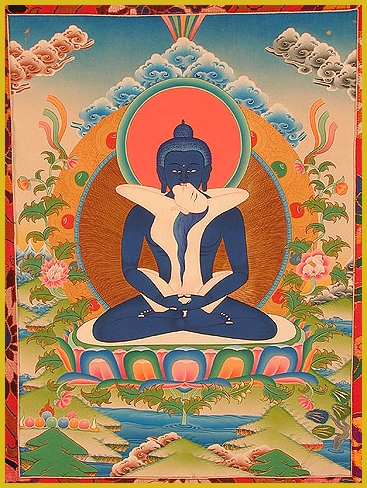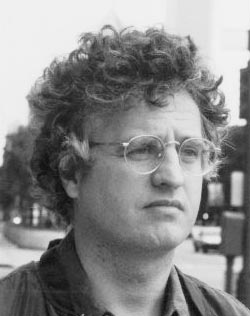
Years ago, I began dating a young woman I was crazy about. I desperately wanted to prove my worth to her as a lover, but it wasn’t helping my cause that I was hopelessly wet behind the ears where lovemaking was concerned. So I figured I’d give myself a leg up by reading a book about Tantric sex, an ancient form of erotic yoga based in Eastern spirituality. During my third encounter of the close kind with my new companion, I decided to try out one of the practices I’d been reading about: a set of straightforward, easy-to-follow instructions for locating and stimulating the female pleasure nexus known as the G-spot.
I was wholly unprepared for the results. This idiot-simple technique, which I’d spent all of 10 minutes studying up on, sent my partner slow-motion bliss-leaping through golden meadows of eternity. Afterward, as angels, stars and butterflies haloed her head, she told me with unmistakable sincerity that she’d just had the single greatest sensual crescendo of her life. “You should write a book!†she swooned, apparently under the very mistaken impression that I was some kind of high-level sexual sorcerer. I tried my best not to shatter that illusion, but inwardly, I was dumbfounded. It was like rubbing a magic lamp and finding out that it isn’t just a story — a genie really does appear.
Why, I wondered, weren’t the sex ed teachers of the world furnishing every human being on Earth with a map to the G-spot and a “Things to Do While You’re There†brochure? How could so many well-respected doctors and scientists straight-facedly claim that this very real erogenous province was no less a fiction than Narnia or Atlantis? Why were countless people suffering from sexual frustration and marital turbulence when they could be having cosmic ka-pows that would make them want to join hands with their neighbors and sing “We Are the World†in the streets?
I’m still asking those questions. To this day, this precious knowledge remains underground, like buried treasure being sheltered from coarse, clutching hands; an occult secret etched on a forgotten temple wall, waiting for gentle fingers to carefully rub away the dust that obscures it.
Though I didn’t know it at the time, the technique that had yielded such explosive results that night was called Sacred Spot Massage, a term coined by Charles Muir. Having almost single-handedly imported Tantric practices to the United States, Muir has been working for 30-plus years to bring skills like Sacred Spot Massage up from the underground and into the hands of the populace.
Knowing firsthand how Sacred Spot Massage can turn a rookie into a Wizard of Ahs in minutes flat, I jumped at the chance to attend a weekend Tantra seminar that Muir and his lover Leah Alchin presented at a golf and country club in Boulder Creek, California.
Hold on tight, my darling. I’m going in.
6:30 p.m. FridayÂ
Inside the golf club’s conference and reception room, 34 people—relationship counselors, professors, psychiatrists, scientists—sit on blue back jack-style floor chairs adorned with lotus emblems. Colorful chakra diagrams and tapestries of Eastern deities hang on the walls and ceilings, and at the rear of the room are some tables loaded with Tantra supplies for sale: DVDs, books, tapestries, lubes, body oils, herbal hard-on pills, relationship runes and a crystal G-spot stimulator.
The group is comprised of eight couples and 14 singles, plus four CTE (Certified Tantra Educator) Assistants. They’ve come from all over: California, Virginia, Texas, Florida, Finland. Most attendees express an interest in healing from past traumas, while some just want to be better lovers or to improve their relationships.
Though there is no nudity or explicit sexual activity in Source School of Tantra’s seminars, students will be given optional “home play†assignments to be completed behind closed doors. In the interest of giving all attendees an opportunity to complete the assignments, the seminar has an equal number of male and female singles. Single people will pair up as study buddies in “Sadie Hawkins†style: Those women who choose to participate will ask the men to dance, so to speak. Under different circumstances, a single guy like me would be thrilled by the large number of beautiful women at this workshop, but as a journalist, I have every intention of remaining a passive observer this weekend. And Snoop Dogg invented calculus.
Any fears I’d had that this workshop was going to be overly New Age-y or phony-holy are demolished when Charles and Leah begin their presentation: They not only talk like real people, but are playful and funny. The cute, ebullient Alchin is about half the age of Muir, who is in what he calls “the third year of my seventh decade on the planet.†If the tall, auburn-haired Muir’s surprisingly youthful appearance is any indication, perhaps there’s truth to all the claims about Tantra’s rejuvenative power.
As an example of repellent sexual behavior to avoid, Charles paws at Leah’s breasts, shouting “Tits!†He then caresses her “heart pillows†(Leah’s wording) in a more loving way, though no less enthusiastically. “You can be noble about it,†he tells the class.
“Oh, noble,†Leah teases. “I love that you’re being noble.â€
Using a light-up wand to represent the lingam (penis) and a large vagina-shaped puppet to represent the yoni (yeah, you guessed it, ace: vagina), Muir and Alchin demonstrate some alternatives to the in-out motion of typical sex. Leah gives a live-action demonstration of some Tantric undulations, which, along with being informative, is pretty hot. I think I’m starting to see why a pre-seminar group email suggested that we wear “non-binding†pants to this workshop.
In an exercise designed to teach us various “modalities of touch†such as static touch, moving touch, squeezing and tapping, I trade arm massages with Aurelia, a beautiful, gold-maned goddess from Sausalito. (By the way, all people in this article are called by their true names. And O.J. Simpson is the Easter Bunny.)
I leave the seminar for the evening with an eight-mile smile. I think I’m gonna like it here.
10 a.m. SaturdayÂ
After getting no sleep whatsoever (nothing new for a born insomniac), I bomb my guts with caffeine and rejoin the group, wondering if tonight’s full moon will make for some Tantric wildness. And holy nectar of the Goddess, does it ever.
In the early part of the day, Charles leads us in some White Tantra (yoga postures, breathing techniques, visualization and chanting) and a tearful, heart-opening puja (worship ritual) in which the men and women give each other healings and show off for each other like birds doing mating dances. We also learn a simple breathing technique for extending the orgasm from the typical five seconds to 20. “Twenty seconds doesn’t sound like a lot more than five seconds, but it’s 20 seconds of timelessness,†Charles states.
There are, however, alternatives to coming. Charles and Leah tell the males that they can learn to “surf†their sexual energy: Rather than getting wiped out by a single wave, they ride the wave of orgasm, oftentimes not ejaculating at all. Tantra teaches men to redirect their orgasmic energy upward, thus conserving their vital essence and, in Charles’ words, “imprinting the sexual energy with visualizations, with affirmation.†Muir does not recommend that men never ejaculate, however. Rather, he advocates that they learn control over the ejaculatory reflex, thus enabling them to choose whether or not to do so. Eventually they will learn to have orgasms without ejaculating.
At lunchtime, I join a large group of singles at a Chinese restaurant called The Red Pearl — a comically appropriate name for a place where a bunch of Tantra students are putting their mouths to good use. (I’m a little surprised not to see any paintings of little men in boats.) When we crack open our fortune cookies at the end of the meal, many of us find fortunes so eerily resonant with the material we’ve been learning that you’d almost suspect this restaurant of keeping special fortune cookies just for Source School of Tantra students. My personal favorite: “You can’t stop the wave, but you can surf it.â€
The excitement mounts in the evening as we’re gearing up for tonight’s home play assignment, in which the men will be pleasuring the ladies with Sacred Spot Massage. While Leah talks with the women about how to receive, Charles leads the guys to his house up the road to teach us the skills that will transform each of us into Señor Amor himself.
Once adequately armed with Sacred Spot knowledge, the men rejoin the women at the reception room. The couples are dismissed to put the day’s teachings into practice, and the singles are encouraged to stick around for the Sacred Spot Massage selection ritual.
As the nervous energy builds, Charles tells the men, “Guys, it would be perfectly normal to leave the room at this point—maybe have some dinner with a couple of our staff members, maybe go back to your room and try out the orgasm extension technique while pleasuring yourself. That would be the normal thing to do.†His delivery is deliberately flat. The subtext is clear: But normal kinda sucks.
After a short pause, he speaks again: “But normal kinda sucks.â€
The man has a point. Like the rest of the men who choose to stay (most of us, if the truth be told), I sit closed-eyed and cross-legged with my hands in prayer-like Namaste position, inhaling the raw intensity of this ceremony. I am still and silent, but my blood is boiling. What if I’m not chosen? What if I am?
A soft, slender hand slips into mine. At Charles’ request, I remain motionless, trying to guess which of the dakinis (female Tantrikas) this might be. When the men are given permission to open their eyes, I find myself gazing upon the beaming face of Grace, an East Bay seminar veteran in her thirties. But there’s a double-take-weird twist here: Grace’s right hand is with me, but her left hand is with Antonio, an amiable, wisecracking 62-year-old Granite Bay businessman who was part of the singles lunch earlier in the day. This woman has chosen both of us. The word to describe this situation would be “novel.â€
Grace explains her plan, and suddenly I’m feeling ex-awesome: For time conservation purposes, she’d like the three of us to converge in one place rather than arranging two one-on-one visits. Antonio and I will be giving her Sacred Spot Massage in shifts, as it were. Yep, it’s official: I’ve lost my happy. The prospect of sexually stimulating someone I’ve just met is already pretty far outside my comfort zone, but when you add the fact that a dude who is roughly my parents’ age will be watching, I start feeling like this bus is headed out there where the dwarves in tutus chase after the masked ponies.
There’s a tennis-match hush as Antonio and I scan each other’s faces: What’s it gonna be? Antonio is the first to speak: Yeah, this is weird, but he’s in. Which means that if I bow out, then I, a thirtysomething rock musician/artist/oddball, will have been out-wilded by a man who gets two dollars off the Belgian Waffle Slam at Denny’s.
Screw it. Charles is right: Normal sucks.
After a surprisingly comfortable conversation over a meal at the Boulder Creek Brewery (“The way the veins stand out in your neck is really interesting,†Antonio tells Grace admiringly), the three of us repair to Antonio’s plush three-bedroom villa by the golf course. As Grace bathes, Antonio and I helplessly scan the bedroom for accoutrements to help turn the room into a temple worthy of a Goddess. Destiny isn’t on our side here: Because of time constraints and other limitations of this three-person setup, neither of us has had a chance to go to the store for room adornments such as rose petals or incense. Is there a handkerchief we could throw over the lamp to dim the light a little? Maybe a CD of some soft music? Finally admitting defeat, we stand near the doorway, absurdly making small talk about golf as we await the return of the woman we’re about to take turns pleasuring. The phrase “How did I get here?†doesn’t even come close.
We don’t need to go into detail about all of the evening’s activities. Some things are a little too explicit even for an article about G-spots and vagina puppets. Suffice to say that everyone present is respectful and cordial, and the experience of helping bring Grace to bliss is actually fairly moving—which is really saying something, considering that this three’s-a-crowd state of affairs has made for a scene so strange that my mind is going to need a chiropractic adjustment afterward. It’s impossible to imagine tomorrow’s festivities being anywhere near as memorable as this.
Then again, some things are beyond imagination.
10 a.m. SundayÂ
Sunday begins with a group tell-all of last night’s adventures. The overwhelming majority of participants have experienced unforgettably beautiful rhapsodies of rapture. Several couples shed tears of joy.
Two women cry for different reasons, however: Their Sacred Spot Massages have triggered painful emotions. As Leah explains, “It’s the Sacred Spot that holds all the emotional qualities: Any trauma, any crisis, any bliss, all get stored in the cellular memories.â€
In other news, Charles and Leah inform the group that this evening, the guys will be doing some receiving of their own: The women will not only treat them to some exotic wand-fondling, but also dare them to accept a finger in what one student calls “the Chocolate Chakra.â€
Last night, a three-way involving another man, and now an experiment in guy-necology, I think to myself. Is Tantra trying to turn me gay? I have no problem with anyone, straight or gay, who feels otherwise, but I have to be honest: My own preference is for my backside to remain an Exit Only zone.
The morning class ends, and I shuffle off to have lunch with some singles, this time at Ironwood’s. (Man, why do all these Boulder Creek restaurants have such Tantra-appropriate names?) Angelica, an attractive, middle-aged lawyer/attorney-mediator from Santa Cruz with whom I connected on Friday evening, stops me at the door. “Are you going to be around tonight for the closing ritual?†she asks.
“Sure.â€
With a hint of a mischievous smile, she shoots back, “Just checkin’,†and disappears into the crowd.
See Spot HideÂ
Leah’s gyrations on Friday night might have been spicy, but this evening, she and Charles raise the bar by demonstrating some elegant sexual positions. Technically, Alchin and Muir are sticking to their “no explicit sexual contact†rule, but let’s not kid ourselves here—these naughty kids are making love with their clothes on.
Like last night, Charles takes the men to his house. This time the roles are reversed: While Leah teaches the ladies the various secret handshakes they’ll be using to please the men in tonight’s home play assignment, Muir instructs the guys on how to receive. Part of this, of course, involves the intimidating Sacred Spot Massage for males. Charles asks us to try to open our minds (etc.) to this part of the ritual: Not only might untold pleasure be waiting for us in this forbidden zone, but because the male Sacred Spot holds a great deal of tension from survival anxiety and other such “first-chakra†issues, having it massaged can help the recipient become literally less “tight-assed†and thus more lighthearted.
According to Muir, this practice also greatly minimizes risks of cancer and/or enlargement of the prostate. What’s more, by putting himself in a position of vulnerability, the man gains a far better understanding of what females go through during sex, their fears about rushing into intercourse, etc. Gotta admit, Charles talks a mean game.
When the men rejoin the women for the puja that will bring the seminar to a close, Angelica immediately asks if I’d like to be her ritual partner this evening. Looks like the excitement isn’t over yet.
The grand finale of the seminar commences. The men form a ring around an inner circle of women, and Charles informs us that we are now letting go of the past and stepping into our new lives of joy and contentment. One by one, the women in the inner circle pair off with the men.
Ember, a fiery-haired tigress from Sacramento, stands before me, her face an uncanny composite of feminine softness and kickass Amazon power. As Charles instructs the men to tell the women with their eyes how incredible they are, I lean toward her a little, making sure she can’t shrug off the message I’m about to send her, and broadcast, I’m not just going through the motions here. You. Are. Fucking. Amazing. A dam bursts behind her face. Tears pour from her eyes. The message has been received. My eyes, too, glaze with tears, mirroring hers.
Now I’m face-to-face with a blonde Russian bombshell named Valentina. For the first time, I become aware of something I’d apparently been too dazzled by this woman’s good looks to fully appreciate: She is stunningly, mind-blowingly beautiful. I tend to be mistrustful of ridiculously pretty women, expecting to find ugliness behind the mask of beauty, but this woman’s sleek gorgeousness reveals itself now as the physical manifestation of divinity itself.
An elder named Rosemary peers into me unwaveringly as I place healing hands over her heart. Etched on her face are tales of moonlit forest gatherings; bonfires on star-haunted beaches; deep loss giving way to calm surrender.
Charles has the men and women sit facing one another, hand-in-hand, and lean toward each other until our partner’s eyes appear to be a single eye on his/her forehead. Marina, my partner for this exercise, morphs into a Cyclops before my eyes. The illusion is truly freaky. When Marina makes a tweaked face that perfectly expresses the weirdness of the effect, we both get a fatal case of “church laugh,†fighting with all our warriorhood to stifle our hysterics.
I stand face-to-face with goddess after goddess, seeing each one’s true beauty and strength as never before. Once the puja is complete, Charles and Leah invite us to sit on the floor and scooch in close. Laughter abounds as our hosts say their farewells.
“I understand there may be an article,†Charles says.
“There will be,†I assure him and the crowd.
Several voices ring out:
“No names!â€
The participants disperse to gather their things, make dates and exchange contact information. As I’m getting my stuff, Marina, who cried while I held her at yesterday’s puja, approaches me to explain the reason for her tears: This was the first time in three years that a man has deeply embraced her without wanting anything from her.
As I hug Grace goodbye, she suggests that I type my article with my right hand while drawing energy from a yoni with my left, the better to charge my writing with Tantric juju. As it began, the workshop ends with laughter.
Happy Ending
Driving away from the seminar, I have a gut feeling—no, a knowing—that my learning has just begun. Tantra has chosen me. Bliss and adventure have chosen me. After years of dabbling, I’m about to be initiated as an honest-to-Goddess Tantra Man.
After stopping at my place to freshen up and drop a few things off, I give the dude in the mirror a quick once-over. “OK, let’s get going, Tantra Man,†I think to myself. I head to Angelica’s place, where we enjoy a lavish dinner. She then leads me up the stairs, where I bathe by candlelight as she prepares her room for our ritual. My body fills with the holy hum of erotic electricity. It knows something special is happening.
Angelica summons me to her bedroom, where a single candle burns. A bed covered with plush pillows is surrounded on all sides by treats for us to enjoy while we celebrate: fine wine, dried fruit, mineral water, cocoanut chocolate.
What follows is beautiful and sweet and unspeakably delightful and hilarious and sumptuous and sacred, and for the six and a half hours that this woman and I play together, we are in love. I call God’s name so many times, you’d think I was in some kind of sex church… which I am. “You are a GENIUS!†I cry out as Angelica gives to me in ways that make life, with all its pain and difficulty, extremely worthwhile.
As for this business about the male Sacred Spot… well, if there’s any of that to be had—and I’m not saying there is—then I suppose this is what I’d have to say about it: It’s nowhere near as painful as I’d feared, and I can certainly see its therapeutic value, but it doesn’t feel any more sexual to me than a bowel movement… which, in case you were wondering, I do not find sexual.
Things start getting hot when Angelica and I are spooning to close the ritual, and it couldn’t be clearer that the Goddess is feeling frisky. My gratitude has put me in a very giving mood, so I make it known that I’m more than happy to reciprocate her gift, if she will so allow.
“We shouldn’t,†she says, not altogether convincingly. “Charles said if we’re tempted to do that, we should set a date for another time, because tonight’s ritual is all about helping you learn to receive without feeling that you have to give back.â€
“I have found an escape clause!†I retort to the attorney with mock seriousness. I proceed to plead my case to the Cosmic Judge: What would please me most is to please this woman, so the best way for her to honor me is to let me honor her, Your Honor. Besides, it was Sunday when we started the ritual, and now it’s Monday, so technically this is a different date.
The logic checks out, at least to the dopamine-engulfed mind. A new Sacred Spot Massage rite begins, and in what can accurately be called no-time, Angelica is howling and writhing in a manner more commonly associated with exorcisms than with sex. Her wails are of such loudness and intensity that at times I honestly wonder if she is screaming in agony. But suffering this is not—it is ecstasy of a greater depth and duration than most people dream possible.
Blissed to high heaven, we collapse together in a pile of loose, oiled-up limbs and tangled hair. “The next time somebody makes a lawyer joke, I’m setting him straight,†I say, giving her neck a little kiss.
Smiling sweetly, Angelica runs her finger across some scratch marks she’s made on my back. “You know what I wrote on your back?†she asks, then giggles and rests her chin on my shoulder. “Tantra Man.â€







